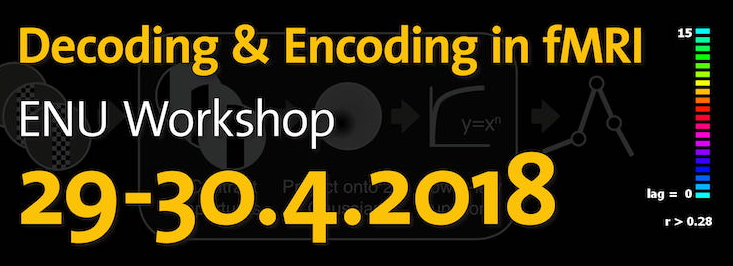
The annual ENU meeting was held on April 29-30, 2018, and focused on decoding and encoding approaches in (f)MRI analysis.
About the workshop:
As the field of MRI research keeps growing rapidly, so do the techniques and methods researchers use to answer their next research question. Developments both in data acquisition and in offline analysis algorithms have increased our ability to extract information from brain activation patterns dramatically. Terms such as decoding and encoding, multivariate pattern analysis (MVPA), representational similarity analysis (RSA), multi-dimensional scaling (MDS), and pattern component modeling (PCM) are being used to map the brain’s organizational and functional principles. All of these methods (and others) hold potential for new discoveries, but using them appropriately may not be straightforward. The workshop will give state-of-the art view of some of these computational tools, the motivation for using them, as well as their advantages and caveats. Lectures will be given by two of the most prominent figures in the field, Dr. Jonathan Winawer (NYU) & Dr. Joern Diedrichsen (University of Western Ontario).
About the lecturers:
Jonathan Winawer
slides I | Slides II | tutorial code
Prof. Winawer has completed his PhD in brain and cognitive Sciences at MIT, titled “Common mechanisms for the representation of real, imagined, and implied visual motion”. He did his post doctorate at Brian Wandell’s lab in Stanford, where he employed various models to study the properties of the visual system. He is currently an assistant professor at NYU psychology & natural science department, where he continues to research how visual stimuli are encoded in the visual pathways, using various sophisticated analysis and modeling methods.
Joern Diedrichsen
Prof. Diedrichsen completed his PhD at Berkeley. He then did his post doctorate in Reza Shadmehr’s lab at Johns Hopkins university, where he studied reach adaptation using fMRI and statistical learning. His group uses imaging methods to understand how the human brain learns and executes movements, with a strong emphasis on computational models. In recent years, he became a leading voice in the ongoing debate about the usage of decoding and encoding methods for understanding fMRI activations. He currently holds the Western Research Chair for Motor Control and Computational Neuroscience at the Brain and Mind Institute, Department for Computer Science, University of Western Ontario.


